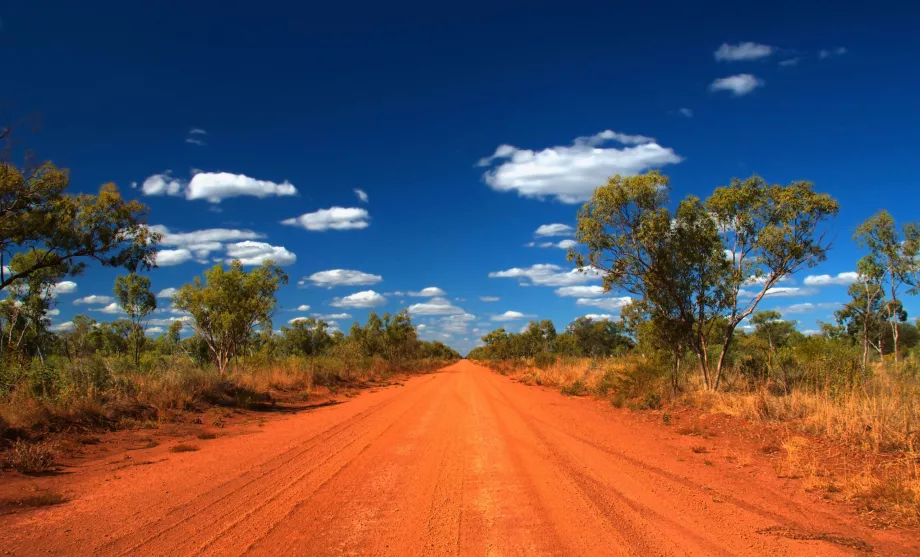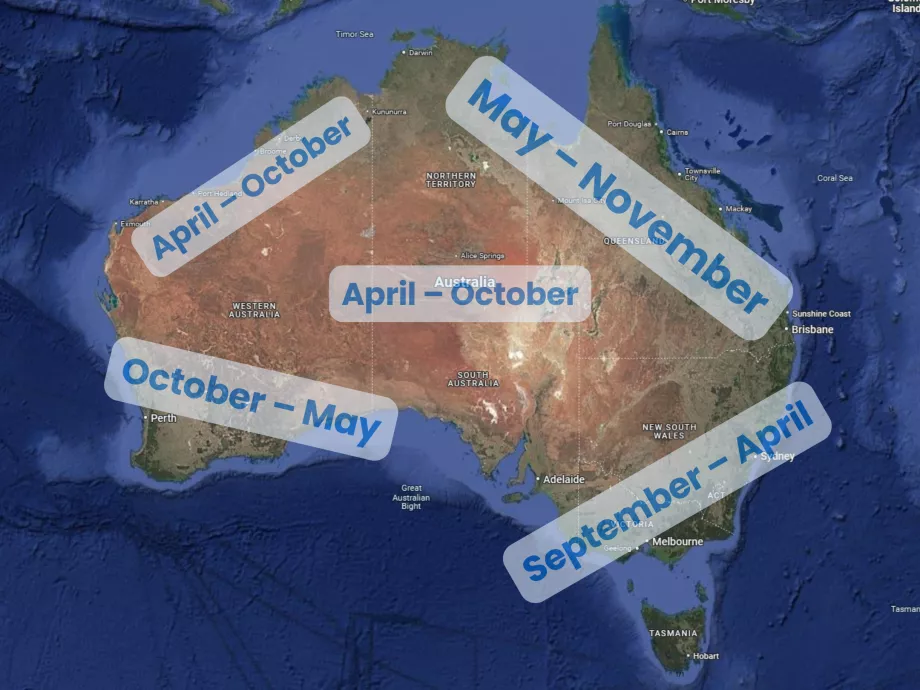Weather in Australia and best time to go

Australia is the smallest continent, but also the 6th largest country in the world, so climate and climate varies greatly across regions.
Find out the prices of flights to Australia in high season
Climate specifics in Australia
In Australia, you will find areas where the 4 seasons alternate (especially the mountains on the border of the states of New South Wales and Victoria, as well as the island of Tasmania), typically tropical areas with rainy and dry seasons, and also desert very hot spots.
When is the hottest time of the year?
All of Australia is in the Southern Hemisphere, which means that summer (the hottest weather) occurs between December and March.
Where do the 4 seasons change and when does it snow in Australia?
The classic winter only prevails in the higher parts of the mountains (above about 900 metres above sea level) in south-eastern Australia and in the highlands of Tasmania.
It regularly snows here from late June to mid-September.
The states of Victoria (city of Melbourne), New South Wales (city of Sydney) and Tasmania alternate between winter, spring, summer and autumn, but winters are very mild and temperatures rarely drop below 10 °C.
When is the rainy and dry season?
The dry and wet seasons alternate in northern Australia (Kakadu National Park, Darwin, Cairns).
There are frequent and very heavy thunderstorms from December to March.
Weaker rainy periods in the same months also occur further south on the east coast around Brisbane, but the storms are not as strong.
Are tropical storms and cyclones a threat in Australia?
The east coast, particularly between the Gold Coast, Brisbane and Cairns, is at risk of severe tropical cyclones (typhoons).
The main season for these storms runs from December to April, but on average there is only about 1 very strong tropical storm every 2 years.
Weather during the year
What is the weather like in Australia at different times of the year?
Weather in January
January is one of the peak seasons in the southern half of Australia. Normal temperatures in cities such as Sydney, Melbourne, Perth and Adelaide range between 27 and 32°C.
There is little rain, and apart from the sun, January is good for swimming in the sea and hiking in the countryside. On the east coast around Brisbane and the Gold Coast, although sunny and warm weather is common, strong thunderstorms can occur.
Conversely, in the north and north-east, January is the main rainy season with very high humidity and temperatures.
It is very hot with extreme temperatures between 37 °C and 45 °C in the central parts of Australia around Uluru National Park.
- Victoria, New South Wales, South Australia, Western Australia, Tasmania
- Low season: South Queensland
- Low season: Northern Territories, Queensland
Weather in February
February, like January, is a summer month and the high season for the southern half of Australia.
There is little rain and, apart from February, it is good for swimming in the sea and hiking in the countryside. Although sunny and warm weather is common on the east coast around Brisbane and the Gold Coast, it is statistically the rainiest month of the year.
Conversely, in the north and north-east, January is the main rainy season with very high humidity and temperatures.
It is very hot with extreme temperatures between 37 °C and 45 °C in the central parts of Australia around Uluru National Park.
- Victoria, New South Wales, South Australia, Western Australia, Tasmania
- Low season: --
- Low season: Northern Territories, Queensland
Weather in March
March is one of the best months to travel to the southern half of Australia.
Temperatures slowly drop, but are still summer-like and range anywhere between 24°C and 32°C. The humidity in the south is low and staying outdoors even in high temperatures is pleasant.
Northern Australia and the centre of the country around Alice Springs and Uluru are unsuitable for travel. In the north, the rainy season is still ongoing and in the middle of Australia, the dry season is at its peak with very high temperatures.
- Victoria, New South Wales, South Australia, Western Australia, Tasmania
- Low season: Northern Territories, Queensland
Weather in April
April is called shoulder season for practically the whole country.
While nowhere is high season, you have a chance of good weather in all parts of the country. In addition, accommodation and car rental prices are significantly lower than in the high season.
Autumn is just beginning in southern Australia, but temperatures are still usually between 15°C and 25°C, ideal for hiking.
The rainy season is leaving northern Australia and although severe thunderstorms can still occur, there is 3-4 times less rain than in previous months.
- High season: --
- Low season: all of Australia
- Low season: --
Book a hotel at a discounted rate
Weather in May
Temperatures in southern Australia can dip below 10°C during May, but in Sydney, for example, they stay around a pleasant 15°C.
The high season starts in the north around the Great Barrier Reef or Darwin.
Pleasant weather with smaller amounts also prevails around the cities of Brisbane and the Gold Coast, and temperatures drop to bearable levels of around 25 °C in the central region around Uluru.
- High season: --
- Minor season: Northern Territories, Queensland, Western Australia, Sydney, Newcastle
- Low season: --
Weather in June
June marks the start of the high season for travel to the interior of Australia and Uluru/Kata Tjuta National Park. Temperatures here are only around 23°C.
The high season also begins in the tropics of northern Australia, on the Great Barrier Reef and around Brisbane, where there is a dry season and pleasant temperatures between 22°C and 25°C.
Northern Australia has consistently high temperatures of over 30 °C.
Pleasant temperatures of around 17 °C are found in Sydney, Adelaide and Perth. Further south in Australia (Melbourne, Great Ocean Road, Tasmania) temperatures can fall below 10 °C.
- High season: Northern Territories, Queensland
- Western Australia, South Australia, Sydney, Newcastle
- Low season: Victoria, Tasmania
Weather in July
July is pretty much the same month as June, just with slightly cooler temperatures across Australia.
There is only sporadic rain in the north, midlands and east coast, while the south sees occasional showers, just like the rest of the year.
There is a rainy season in Western Australia, but it is not as intense as the summer rainy season in the north.
- High season: Northern Territories, Queensland, ski season in the mountains
- South Australia, Sydney, Newcastle
- Low season: Victoria, Tasmania, Western Australia
August weather
During August, the weather is identical to July, but temperatures gradually increase across the country.
In the north around Darwin, temperatures are typically around 31°C, Brisbane or Alice Springs around 22°C, Sydney, Adelaide or Perth around 18°C and the very south around Melbourne and Tasmania below 15°C.
- High season: Northern Territories, Queensland, ski season in the mountains
- South Australia, Sydney, Newcastle
- Low season: Victoria, Tasmania, Western Australia
September weather
During September, temperatures in the south rise to an average of 19°C and the weather becomes pleasant again for touring the southernmost parts of Australia.
The main dry season and pleasant temperatures still prevail in the north, east coast and desert areas of central Australia with temperatures around 25°C to 31°C.
- High season: Northern Territories, Queensland, ski season in the mountains
- South Australia, Sydney, Newcastle
- Low season: Victoria, Tasmania, Western Australia
Weather in October
Like April, October is the so-called shoulder season, the transition period between the high season and the low season for virtually the entire country.
Great spring weather prevails in south-eastern Australia and a pleasant transition period between drought and rain with only brief showers in northern Australia and Queensland.
Even central Australia around Uluru can still be good to visit with temperatures up to 32°C.
- High season: --
- Low season: all of Australia
- Low season: --
Buy a cheap flight to Australia
Weather in November
Mid-November marks the start of the main summer season in the southern part of the country (Sydney, Melbourne, Adelaide, Perth, Tasmania), with temperatures regularly rising above 23°C.
Around Brisbane, the rainy season arrives but is not so heavy as to make travel impossible. Showers usually only occur for a few dozen minutes at most in the evening, so even Queensland is a good place to visit with summer temperatures over 30°C.
Even the full tropical north can be a good month to visit in November, as even here the rainy season hasn't fully arrived.
Temperatures in the Uluru area soar to between 35 °C and 40 °C.
- High season: New South Wales, Victoria, Tasmania, South Australia, Western Australia
- Low season: --
- Off-season: Central Australia (Uluru, Kata Tjuta, Alice Springs)
Weather in December
By December, summer is in full swing. Temperatures across Australia routinely exceed 30°C (86°F).
While the humidity in the south is low with only occasional showers common, the rainy season and torrential downpours are in full swing in the northern tropics.
The Queensland coast and Great Barrier Reef are also scraped by frequent thunderstorms, but usually only in the evening and travel to these areas is easily possible.
The desert areas around Uluru are plagued by temperatures of around 39°C.
- High season: New South Wales, Victoria, Tasmania, South Australia, Western Australia
- Low season: --
- Off-season: Central Australia (Uluru, Kata Tjuta, Alice Springs)
Table of temperatures during the year
Southeast (Sydney, Melbourne) - Ideal for swimming, surfing and urban hiking
Centre - Adventures in the desert and around the rock of Uluru
North - Jungle and coral reef adventures
Brisbane and Gold Coast -
West - Perth area
When to go to Australia
The ideal months to visit will be the so-called shoulder seasons, i.e. October, November, March and April, when the weather will be pleasant and the tourist season not so high.
However, it is worth flying to Australia in any month. As we describe above, there is a high season or very pleasant climate in some part of Australia at every time of the year.
Plan your trip to Australia according to what activities you particularly want to do here.
- Hiking and nature tours - April, May, October, November (for northern Australia especially June to October)
- Beaches and swimming - November to March
- Surfing and water sports - November to March for South Australia, June to October for Queensland
- Snorkelling and diving off the Great Barrier Reef - June to October
- Visiting the desert and Uluru - May to October
- Skiing - July and August
Any questions left?
If you have any questions or comments about the article...


